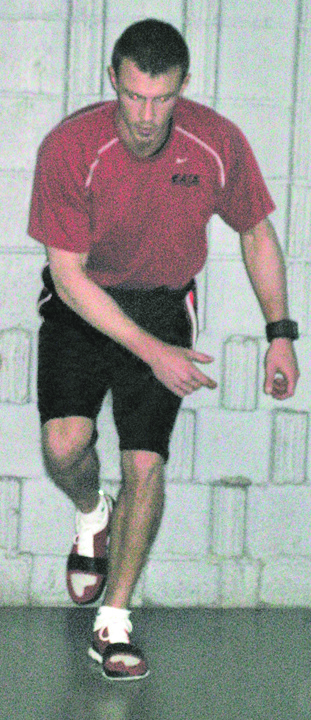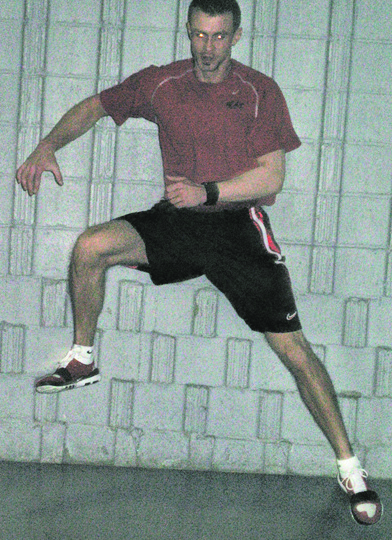In order for your team to reach its true potential on the basketball court, they must maintain the strength they built throughout the entire offseason. As obvious as it sounds, strength training is still a greatly underestimated aspect of preparation in many programs and often a neglected component during the actual playing season.
Just remember, your players are not Olympic lifters, power lifters, or bodybuilders, so they need not train that way. A safe, time-efficient and productive in-season program can take as little as 20 minutes twice a week.
The primary purpose of a strength training program is to reduce the occurrence and severity of injury. Basketball is very demanding physically. Making the muscles, ligaments, and tendons of the body stronger will lessen the occurrence and/or severity of an injury (such as a pulled groin or rolled ankle), and keep your players on the court. Further, you will improve their performance on the court. The stronger your player is, the more force they can produce. The more force they can produce, the higher they can jump and the faster they can run.
But most importantly, strength is an attribute that can quickly diminish. In as little as three weeks your players may have a noticeable decrease in strength. That means every week that goes by, your team is getting weaker. Come playoff time your team will be physically at their weakest when you need them at their strongest.
How to Approach It
There are as many different strength training methodologies as there are ways to run a full court press or a fast break. Regardless of what you choose, safety, time efficiency and intensity should be the backbone of your strength training philosophy. Your main focus during the season should be to maintain (if not improve) each player’s overall muscular size and strength. Your in-season program should address their major muscle groups (legs, hips, core, and upper torso) as well as paying special attention to the most injury-prone areas: ankles, knees, groin, lower back, and hands.
Your goal as a coach should be to minimize risk within the training atmosphere. You should only use the safest exercises available, and do your best to make sure that all workouts are properly supervised. Players should always perfect exercise technique and form prior to utilizing additional resistance or weight. Additionally, players should perform every movement in a slow, controlled, and deliberate fashion, with special emphasis focused on the lower portion of each lift. Lastly, your players should work within an appropriate repetition range (8-15 reps for most high school and college basketball players) and avoid maxing out (seeing how much weight can be lifted in one repetition), as these practices can be very dangerous.
Time is a precious commodity for both you and your players, especially during the season. Therefore, the goal of your in-season strength program should be to get the best results possible in the shortest amount of time. You should use a limited number of sets and exercises during each workout (1-2 sets per exercise), while minimizing rest intervals (very little rest in between sets) to induce an overall conditioning effect. This will make each workout brief, but intense.
Intensity is the most important controllable factor in determining the results for your players. Below a certain level of intensity, strength training will have very little benefit. I define intensity as the level of effort exerted by the individual being trained. If a player is capable of lifting 100 pounds 15 times and they stop at 10, the exercise was clearly not as intense as it could have been. Therefore, it is recommended that each set is taken to the point of momentary muscular fatigue--the point at which no additional reps can be completed.
As you can see, there is not much difference between your off season strength training philosophy and your in season philosophy, with the exception of the volume. Given your players will be practicing and playing almost every day (at high levels of intensity) and will be in a constant state of fatigue from November to March, it is recommended you decrease the volume of each workout to reduce the overall wear and tear on their bodies. Do fewer sets and less total exercises, especially for the lower body.
While you certainly want your program to have balance, and work all muscle groups, the core is extremely important to staying injury free and performing well on the court. The core consists of the abdominals, lower back, obliques and hips, and is the center of all movement--which means core training is extremely important for basketball players. A strong core may help prevent hip and lower back injuries (which are especially common among taller players).
Manual Resistance
Manual resistance exercises are a fantastic tool to use during the season, as they require no equipment, can be done anywhere (which is great when your team is traveling), encourage communication among players, and are an effective way to build and maintain strength. Manual resistance exercises are strength training exercises in which a partner or coach applies the resistance instead of using weight such as a traditional barbell, dumbbell, or machine.
It is important to make sure that you and each member of your team understands the concept of manual resistance, so that the exercises are as productive as possible. Further, it is important that your team performs these exercises correctly, learning to apply resistance evenly throughout the entire range of motion and making sure that there is resistance on both the positive and negative portion of exercises.
The responsibilities of the lifter include performing slow and controlled repetitions, pausing at full contraction, and giving constant tension through a full range of motion. More specifically, this means that they need to “push or pull” against the tension the spotter provides on the positive part of the movement and “resist” against the tension on the negative portion. A common mistake many players make is not resisting during the negative of exercises. The responsibilities of the spotter include applying variable resistance through the entire range of motion and making sure the lifter keeps good posture.
In-Season Strength Training Workout Samples
- Basketball push-ups
- Pull-ups
- Manual resistance lateral raise
- Dumbbell standing shoulder press
- Manual resistance rear deltoid
- Seated row
- Dips
- Barbell curl
- Plate pinchers (grip)
- Forward & lateral lunge
- One-legged dumbbell squat
- One-legged leg curl on physio ball
- Manual resistance hip adduction (groin)
- One-legged dumbbell calf raise
- Basketball plank hold (core)
- Basketball woodchoppers (core)






